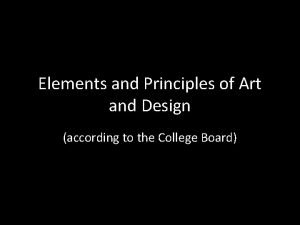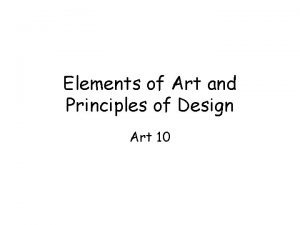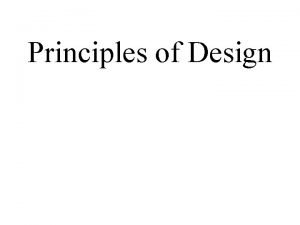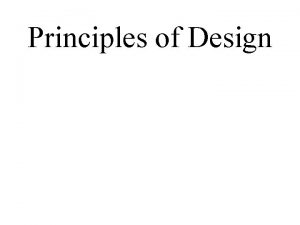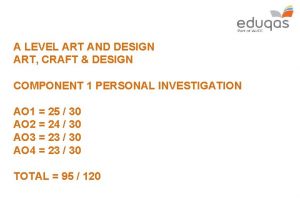The Principles of Art and Design Principles of


















- Slides: 18

The Principles of Art and Design

Principles of Whhha. T? • The principles of art are the set of rules or guidelines of art that are to be considered when considering the impact of a piece of artwork. They are combined with the elements of art in the production of art

Balance • Balance refers to the distribution of visual weight in a work of art. • Types of Balance: asymmetrical, radial

Symmetrical Balance • Symmetrical balance can be described as having equal "weight" on equal sides of a centrally placed fulcrum. It may also be referred to as formal balance.

Asymmetrical Balance • Asymmetrical balance, also called informal balance involves placement of objects in a way that will allow objects of varying visual weight to balance one another around a fulcrum point.

Radial Balance • Arranging elements equally around a central point , resulting in radial symmetry.

Movement • Visual movement is used by artists to direct the viewers’ eyes through a work of art.

Movement

Movement

Rhythm • Is the repetition of visual movement using color, shapes, or lines. Movement and rhythm work together to create the visual equivalent of a musical beat

Rhythm

Pattern • Uses the elements of art in planned or random repetitions that enhance the surfaces of paintings or sculptures.


Contrast • Contrast refers to differences in values, colors, textures, shapes and other elements.

Emphasis • Emphasis in a composition refers to developing points of interest to pull the viewer's eye to important parts of an artwork.

Unity • Unity or harmony is the quality of wholeness or oneness that is achieved through the effective use of the elements and principles of art.

Unity

Your Assignment • Choose one of your own artworks and find as many principles of design as you can. • Choose a famous work of art and find as many principles of design as you can. • Put a thumbnail of each in a Word document along with your list and hand in to me by the end of class.
 The relative size of different elements of an artwork
The relative size of different elements of an artwork Line shape form color texture space
Line shape form color texture space Principles of art design in dtp
Principles of art design in dtp Principles of interior design ppt
Principles of interior design ppt Hình ảnh bộ gõ cơ thể búng tay
Hình ảnh bộ gõ cơ thể búng tay Bổ thể
Bổ thể Tỉ lệ cơ thể trẻ em
Tỉ lệ cơ thể trẻ em Gấu đi như thế nào
Gấu đi như thế nào Thang điểm glasgow
Thang điểm glasgow Hát lên người ơi
Hát lên người ơi Môn thể thao bắt đầu bằng chữ f
Môn thể thao bắt đầu bằng chữ f Thế nào là hệ số cao nhất
Thế nào là hệ số cao nhất Các châu lục và đại dương trên thế giới
Các châu lục và đại dương trên thế giới Công của trọng lực
Công của trọng lực Trời xanh đây là của chúng ta thể thơ
Trời xanh đây là của chúng ta thể thơ Mật thư tọa độ 5x5
Mật thư tọa độ 5x5 Phép trừ bù
Phép trừ bù Phản ứng thế ankan
Phản ứng thế ankan
